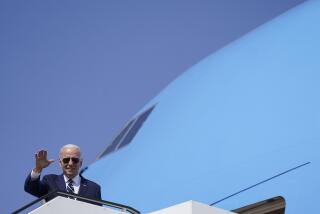United States Is Giving Up Ground as Investor in Asia : TRADE BOOM: The Rise of Intra-Asia Commerce
- Share via
BANGKOK, Thailand — Back in the 1960s, American aid paid for the construction of the first modern highways in Thailand. But today Japanese cars fill them.
The contrast underscores a point that is becoming clear to American diplomats and executives: American investment in Asia isn’t keeping up with Asia’s growth.
Secretary of State James A. Baker III noted at an annual ministerial conference of the Assn. of Southeast Asian Nations that U.S. investment in ASEAN countries had more than doubled since 1982 to $10 billion. But Richard H. Solomon, assistant secretary of state for East Asia and the Pacific, acknowledged that the American share of new investments is falling behind Asia’s own investors.
“It’s hard to see a very positive picture for U.S. business out here (in Asia),” said Bob Martin, managing director of Colgate-Palmolive (Thailand), who ranks himself among the concerned despite his company’s success.
The firm, which has been manufacturing in Bangkok since 1958, sells $120 million in soaps and toothpaste products in Thailand annually and ranks first or second in the market with nearly all of its goods.
“If we are going to compete out here, we are going to have to have the weapons to do so,” said Martin, former president of the American Chamber of Commerce in Bangkok.
Those “weapons,” he said, include access to low-cost financing, specialists in economic development and an understanding of how to cultivate relations with the government and private sector.
“Japanese spend a lot of time building relations with the government and the private sector. Americans spend their time here associating with other Americans. The only time American companies try to develop a relationship with the government is when they have a problem,” he complained.
Leonard Chinitz, who heads the Bangkok office of Kaplan Russin & Vecchi, a pan-Asia law firm, said: “We are in retreat. We can’t hold on to the good old days forever.”
David L. Hendrix, Citibank’s vice president and country corporate officer for Thailand, predicted that American investment as a percentage of the total in Asia will continue to decline. But he was less alarmed by that prospect than others are.
“It’s wrong to expect the United States to compete in all areas of the market,” he said. However, he also said he “would like to see Americans pay less attention to Eastern Europe and more attention to Southeast Asia.”
The region’s trade is burgeoning. Thailand, with $32 billion in imports, buys more abroad than the combined $27 billion of all East European countries, according to Phisit Pakkasem, deputy secretary general of the National Economic and Social Development Board.
The United States played a key role in spurring an investment boom in Asia that is driving much of the region’s growth.
Its lead in the 1985 decision to drive down the value of the dollar added new punch first to the Japanese yen, then to the Taiwan dollar and finally to South Korea’s won. Wages and the costs of exports from factories at home suddenly skyrocketed--but so, too, did the overseas purchasing power of firms in all three countries.
The United States added another spur to investment elsewhere in Asia when it removed South Korea and Taiwan from its Generalized System of Preferences (GSP), denying manufacturers in those two countries the low tariffs enjoyed by imports from developing nations.
Locating four factories in Thailand and Malaysia saved tariffs of 4.5% to 14% on sales in the U.S. market for the Micom division of Taiwan Liton Electronic Co.
“That’s a big plus,” said Huang Chingfu, the firm’s vice president, who said the lower tariffs resulting from the GSP differential figured prominently in his company’s decision to establish four factories in those two countries.
Northeast Asian manufacturers are also moving overseas to secure American quotas for exports of products such as shoes and textiles, an American lawyer in Taipei said.
Massive traffic jams in Bangkok and most other Asian capitals testify to the growing market for automobiles throughout the region--which Kenneth S. Courtis, senior economist for Deutsche Bank Capital Markets, predicted would provide two-thirds of the growth in world demand for cars during the 1990s.
Detroit auto executives acknowledge that Asia is the next boom market, but there are few signs that the Big Three will share much of it.
Thailand’s 13 auto manufacturers are selling 300,000 vehicles a year--a 3.8-fold growth since 1986--and heading toward 500,000. But, according to Nimit Nontapunthawat, chief of the Bank of Bangkok’s research department, “it’s probably too late” for the Big Three to grab a part of the action.
“The number of American cars on the streets is so small that they probably could not develop the scale of market here that would be necessary to make manufacturing pay,” he said.
Ford and General Motors are taking another look at the Thai market, according to an American banker in Bangkok, but Courtis predicted that American manufacturers will be so hard-pressed to defend their own market against Japanese inroads in the 1990s that they will be unable to plunge into Asia.
Japanese auto makers, he predicted, will probably take about 60% of the Asian growth.
Nimit said Thailand exports vehicles to Canada and Europe, and “certainly will become a major exporter of both pickup trucks and passenger cars in the near future.”
Mazda, he said, plans a manufacturing plant here with a capacity of 100,000 vehicles, many for export. And throughout Southeast Asia, Mitsubishi Motors, Toyota and Mazda are establishing regionwide networks of interrelated production.
More to Read
Inside the business of entertainment
The Wide Shot brings you news, analysis and insights on everything from streaming wars to production — and what it all means for the future.
You may occasionally receive promotional content from the Los Angeles Times.










